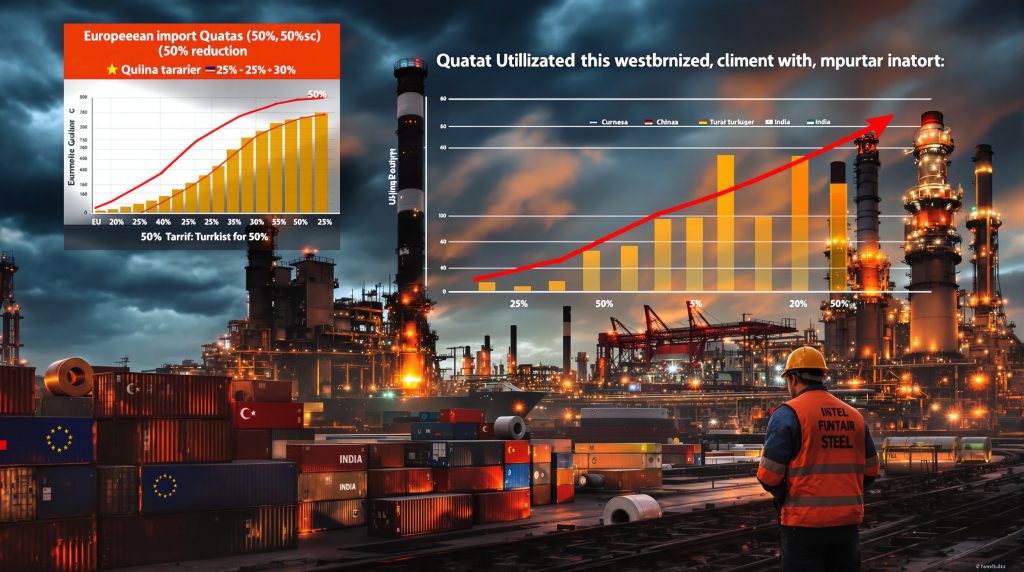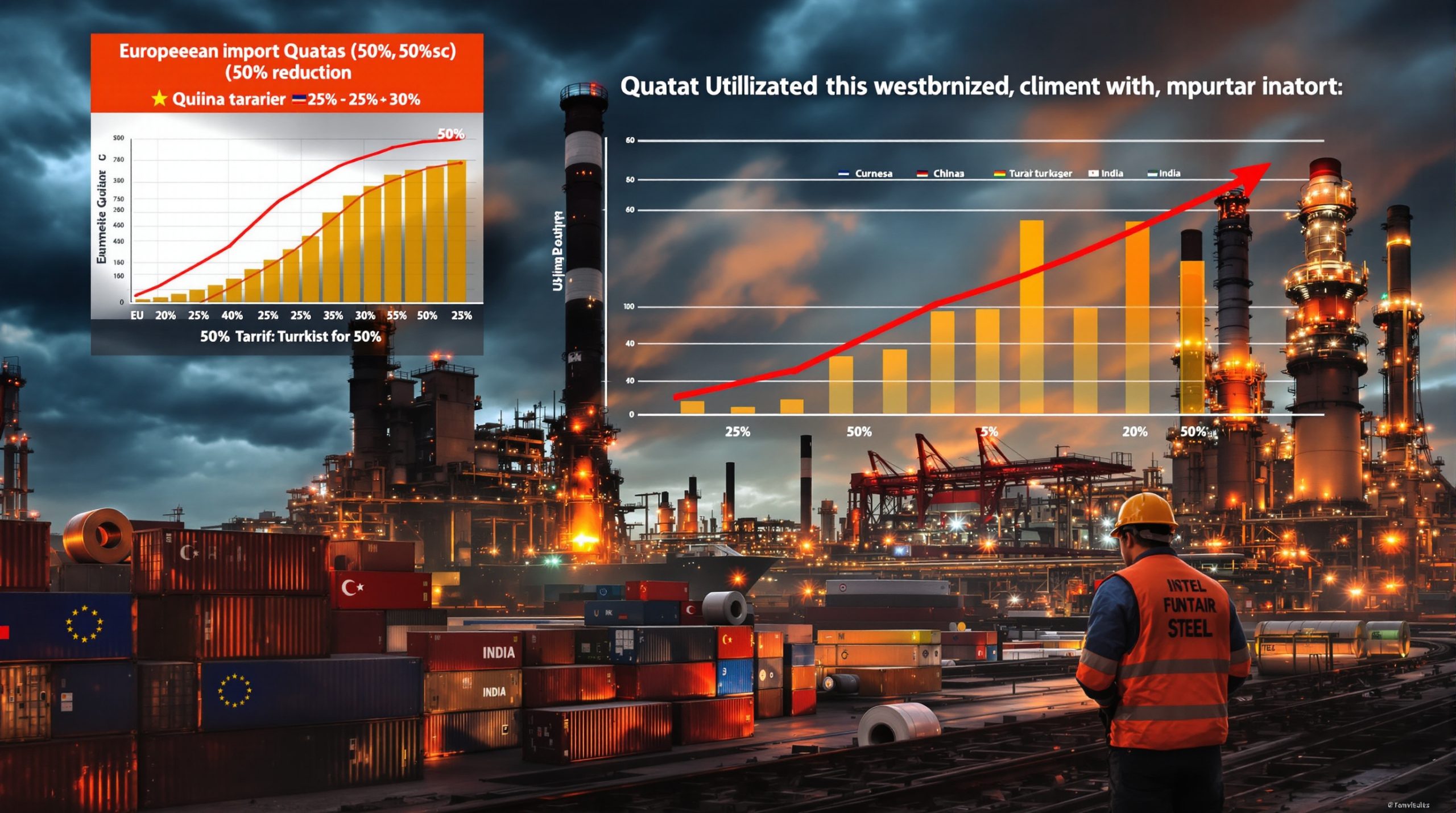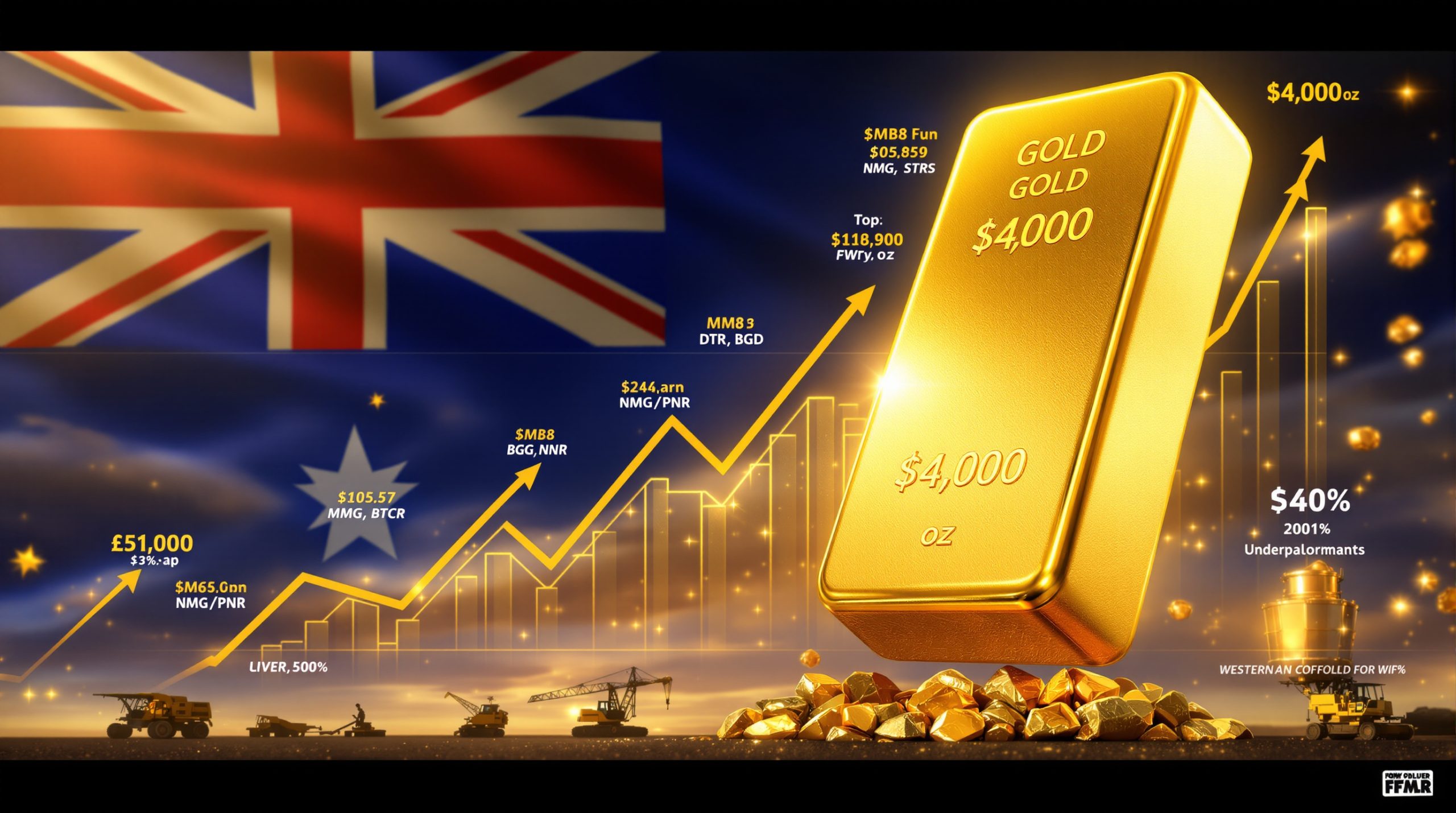What Are the EU's Steel Import Quotas?
The European Union maintains a complex system of tariff-rate quotas (TRQs) for steel imports designed to shield domestic producers from global overcapacity. These quotas establish volume thresholds for steel entering the EU market at standard tariff rates, with higher duties applying once these limits are exceeded. The framework includes country-specific allocations for major trading partners and product-specific "residual quotas" for other nations, creating a multi-tiered import management system.
The current quota system is approximately 26% above original levels despite market demand having declined significantly since their implementation, according to October 2025 data from Reuters. This growing disconnect between import allowances and actual market needs has intensified pressure on European producers struggling with various economic challenges.
Legal Foundation and Timeline
Implemented initially as temporary safeguard measures in 2018, the EU steel quota system has undergone several revisions to adapt to changing market conditions. The current framework operates under World Trade Organization (WTO) rules that permit temporary trade restrictions to prevent serious injury to domestic industries.
These safeguards are scheduled to expire in mid-2026, though the European Commission is already developing replacement mechanisms to maintain market protections beyond this date. The regulatory approach attempts to balance WTO compliance requirements with the practical need to shield European steel producers from market distortions caused by global commodity tariffs.
Why Is the EU Changing Its Steel Import Quotas?
Global Overcapacity Crisis
The global steel industry faces a structural overcapacity crisis of historic proportions. According to OECD projections cited by Reuters, excess steel production capacity will reach an estimated 721 million metric tons by 2027. This massive imbalance has created significant market distortions globally, with subsidized production flooding international markets at prices that often don't reflect true production costs.
This overcapacity problem is particularly pronounced with Chinese steel production, which continues to expand despite weak domestic demand. The resulting export pressure has destabilized markets worldwide and threatens the viability of European producers who operate with stricter environmental standards and higher energy costs.
Demand-Supply Mismatch
A critical factor driving quota revisions is the widening gap between European steel consumption and import allowances. Since the quotas were first established, European steel demand has declined significantly due to economic slowdowns, reduced construction activity, and automotive sector challenges.
Despite this market contraction, import quotas have increased by approximately 26% above their original levels, according to industry data cited by Reuters. This misalignment has intensified competitive pressure on domestic producers already battling high energy costs and making substantial investments in decarbonization technologies.
International Alignment
The EU's proposed quota reductions and tariff increases align with similar protective measures implemented by other major steel-producing regions. Both Canada and the United States maintain 50% tariffs on imports of excess steel, creating a coordinated Western approach to managing global steel trade imbalances.
This international alignment reflects growing recognition among Western economies of the need to develop coordinated responses to market distortions. By harmonizing trade defense instruments, these economies aim to prevent import diversion where restricted products simply flow to markets with weaker protections.
What Changes Are Being Proposed to EU Steel Import Quotas?
Quota Volume Reduction
The European Commission plans to propose cutting steel import quotas by nearly 50%, according to Reuters reporting from October 2025. This dramatic reduction aims to recalibrate import volumes to better match current market demand conditions and provide breathing space for domestic producers facing multiple competitive and cost challenges.
The proposed cuts represent the most significant adjustment to the EU steel safeguard system since its implementation. European steel groups have been actively advocating for this substantial reduction, arguing that current quotas no longer reflect market realities and undermine the industry's sustainability.
Tariff Rate Increases
For imports exceeding the new reduced quotas, the Commission will propose increasing tariffs from the current 25% to 50%. This doubling of excess-volume duties represents a substantial escalation in trade defense measures and directly mirrors the tariff levels imposed by the United States and Canada.
The higher tariff rate is designed to create a stronger deterrent against excessive imports while still maintaining market access for strategic trading partners within reasonable volume limits. Unlike the U.S. system where tariffs "apply from the very first ton," the EU's approach maintains a quota-then-tariff structure that provides more flexibility for trading relationships.
Announcement Timeline
The comprehensive steel sector package containing these measures is scheduled for official announcement on October 7, 2025. Industry stakeholders have already received preliminary briefings from Stephane Sejourne, the Commission's executive vice president for industrial strategy, according to Reuters reporting.
European steel association Eurofer, through its president Henrik Adam (who also serves as vice president of Tata Steel), has expressed cautious optimism following these briefings. While avoiding disclosure of specific details, Adam indicated that Sejourne had "reassured attendees their message had been understood" regarding industry concerns about quota levels and tariff rates.
How Will These Changes Impact the Steel Market?
Price Implications
The significant reduction in import quotas will likely create upward pressure on European steel prices as supply constraints tighten. This effect could benefit European producers by improving profit margins needed to fund essential investments in decarbonization technologies and maintain production capacity.
However, price increases may be moderated by ongoing weak demand in key steel-consuming sectors such as construction and automotive manufacturing. The European Commission will need to carefully balance market protection with the risk of creating cost pressures for downstream industries that use steel as an input material.
Trade Flow Disruptions
Countries heavily dependent on steel exports to the EU will face substantial challenges adapting to the reduced quotas. Major exporters like Turkey, India, South Korea, and Vietnam may need to redirect shipments to alternative markets or reduce production volumes, potentially creating ripple effects throughout global steel trade flows.
The adjustment process could be particularly challenging for specialized product categories where producers have optimized their operations specifically for European market requirements. Some manufacturers may need to reconfigure production lines or develop new product offerings to maintain business viability under the tighter import regime.
Domestic Producer Benefits
European steelmakers stand to gain market share and improved pricing power from the tightened import restrictions. The measures provide critical support for the industry's ongoing decarbonization investments, which require stable revenue streams to fund capital-intensive green steel technologies.
The protection could prove especially valuable for integrated steelmakers pursuing hydrogen-based production methods and other low-carbon technologies. These transformative investments typically require decades-long planning horizons and stable operating conditions that are difficult to maintain in markets distorted by subsidized imports.
What Is the Global Context for These Steel Trade Measures?
US-EU Metals Alliance
The proposed quota changes align with the recently announced "metals alliance" between the EU and United States, established in July 2025 according to Reuters reporting. This partnership aims to coordinate trade policies to protect their respective steel industries from subsidized imports and develop common approaches to decarbonization.
The alliance seeks to replace current US Section 232 tariffs with a quota-based system similar to the EU model. EU trade chief Maros Sefcovic met with US Trade Representative Jamieson Greer in Asia to advance these discussions, reflecting the strategic importance both economies place on resolving steel trade tensions and creating a more stable market framework.
China's Production Expansion
Chinese steel production capacity continues to grow despite global overcapacity concerns, with new facilities coming online despite weak domestic demand. Reuters reporting indicates that European and Western allies are explicitly working to "ring-fence their respective production from China" through coordinated trade measures.
This ongoing capacity expansion has prompted coordinated responses from Western economies seeking to prevent market distortions from subsidized production. The situation exemplifies broader tensions in the US‑China trade war where market-oriented economies struggle to compete with state-supported industries operating under different economic models.
WTO Implications
The EU's safeguard measures must comply with World Trade Organization rules, which limit the duration and scope of such protections. The planned expiration in 2026 reflects these constraints, though the EU is developing alternative mechanisms to maintain market protections within the WTO framework.
This balancing act between WTO compliance and industry protection needs has become increasingly challenging as global trade tensions have escalated. The EU must carefully design its new measures to withstand potential legal challenges while still providing effective protection for its strategic steel industry.
How Do EU Steel Import Quotas Work in Practice?
Quota Administration System
The EU's steel safeguard system divides import quotas among product categories and countries, with allocations reset quarterly. This approach provides regular market access opportunities while preventing sudden import surges that could destabilize domestic producers.
Once a country exhausts its quarterly quota for a specific product, additional imports face higher tariffs until the next quarter begins or unless residual quotas remain available. This mechanism creates a managed import flow that maintains market access while avoiding the disruptive effects of concentrated shipments.
Monitoring and Enforcement
The European Commission maintains a real-time tracking system for quota utilization, with customs authorities across member states enforcing the restrictions. This sophisticated monitoring infrastructure enables prompt detection of unusual import patterns that might indicate circumvention attempts.
Industry analysis has revealed that certain high-demand product categories see their quotas exhausted within days of each quarterly reset, highlighting the intense import pressure in specific market segments. This pattern underscores the competitive dynamics that have prompted the proposed quota reductions.
Exemptions and Special Provisions
Developing countries with minimal market share (under 3%) receive exemptions from the quota restrictions to maintain their development opportunities. Additionally, the system includes provisions for critical supply situations and specific end-use applications, though these exceptions are narrowly defined and carefully monitored.
These exemptions reflect the EU's attempt to balance domestic industry protection with broader development goals and supply chain resilience needs. The careful calibration of these provisions helps maintain the system's legitimacy while addressing specific market requirements.
What Other Steel Industry Measures Is the EU Considering?
Scrap Metal Export Controls
Alongside import quota changes, the EU is investigating potential export duties on scrap metal to secure raw material supplies for domestic producers, according to Reuters reporting. This measure would complement import restrictions by addressing the full supply chain for European steelmakers.
Scrap metal represents a critical resource for lower-carbon steel production methods, particularly electric arc furnace technology. By ensuring adequate domestic supply of this material, the EU aims to support both industry competitiveness and environmental goals through more efficient resource utilization.
Aluminum Safeguard Investigation
The European Commission has launched a parallel investigation into aluminum market trends to determine whether similar safeguard measures are warranted for this sector. This reflects growing concerns about global overcapacity extending beyond steel to other base metals critical for industrial applications.
The aluminum investigation demonstrates the Commission's comprehensive approach to industrial strategy, recognizing the interconnected nature of metal markets and the similar competitive challenges faced across these sectors.
Green Steel Transition Support
The comprehensive steel package will likely include measures to support the industry's decarbonization efforts, potentially including carbon border adjustment mechanisms, innovation funding, and regulatory frameworks for low-carbon production certification.
These supportive measures recognize that European producers face significantly higher costs in transitioning to low-carbon production methods compared to competitors in regions with less stringent environmental regulations. The integrated approach aims to create market conditions that reward carbon efficiency while maintaining industrial competitiveness.
What Are the Key Stakeholder Perspectives on These Changes?
Steel Industry Position
European steel producers, represented by Eurofer, have advocated strongly for quota reductions and higher tariffs. The industry argues these measures are essential for survival amid global overcapacity and the high costs of transitioning to low-carbon production methods.
Henrik Adam, in his dual role as Eurofer president and Tata Steel vice president, has expressed cautious optimism following preliminary briefings on the proposed measures. This positive reception suggests the Commission's proposals align substantially with industry recommendations on quota levels and tariff rates.
Steel Consumer Concerns
Downstream industries that use steel as an input material have expressed concerns about potential price increases and supply constraints. Automotive manufacturers, construction companies, and appliance makers may face higher costs that could ultimately be passed to consumers.
These sectors emphasize the need for balanced measures that protect primary steel production without creating undue cost pressures or supply disruptions for manufacturing industries that employ millions of European workers and contribute significantly to export earnings.
International Trading Partner Reactions
Major steel exporters to the EU have criticized the proposed measures as protectionist and potentially harmful to global trade. Some countries have threatened retaliatory measures against European exports if the new quotas and tariffs are implemented.
These tensions highlight the complex balancing act facing trade policymakers, who must weigh domestic industry protection against international relationships and the risk of escalating trade barriers that could tariffs impact markets and damage broader economic interests.
How Do EU Steel Quotas Compare Internationally?
US Section 232 Measures
The United States maintains significant tariffs on steel imports under its Section 232 national security provisions. According to Reuters reporting, unlike the EU's quota-then-tariff approach, US tariffs "apply from the first ton imported," creating a more restrictive system for many trading partners.
Some countries have negotiated alternative arrangements with the US, creating a complex patchwork of bilateral deals. The ongoing US-EU metals alliance discussions aim to develop a more harmonized approach that would replace these tariffs with a quota system more closely aligned with the EU model.
UK Post-Brexit System
Following Brexit, the United Kingdom established its own steel safeguard system modeled on the EU framework but tailored to British market conditions. This parallel system creates additional complexity for producers serving both markets, who must navigate two different regulatory regimes.
The UK system maintains many features of the EU approach while adapting quota volumes to reflect the smaller size of the British market. This regulatory divergence exemplifies the broader challenges created by Brexit for integrated industrial supply chains.
Emerging Market Approaches
Developing economies with growing steel industries, such as India, Vietnam, and Indonesia, have implemented their own import restrictions to protect domestic producers, creating a complex global patchwork of trade barriers affecting steel flows.
These measures often reflect concerns similar to those driving EU policy: the need to shield developing industrial capacity from global overcapacity while creating space for technology development and environmental improvements. However, they also contribute to market fragmentation that increases supply chain complexity.
FAQs About EU Steel Import Quotas
How will reduced quotas affect steel prices in Europe?
The substantial quota reduction is likely to create upward pressure on European steel prices, though the extent will depend on overall demand conditions and the response of domestic producers. Analysts project potential price increases of 5-15% for affected product categories, with specialized products potentially seeing larger increases due to more limited supply options.
Which countries will be most affected by the new quota limits?
Major steel exporters to the EU, including Turkey, India, South Korea, and Vietnam, will face the greatest impact from reduced quotas. These nations may need to redirect exports to alternative markets or adjust production volumes accordingly. The adjustment challenges will vary significantly based on product specialization and the availability of alternative markets.
How do these measures support the EU's climate goals?
By providing market protection for European producers, the measures support investment in decarbonization technologies required to meet the EU's 2050 climate neutrality target. Stable revenue streams are essential for funding the capital-intensive transition to green steel production, including hydrogen-based reduction processes and electric arc furnace technologies that can significantly reduce carbon emissions.
Will these changes lead to steel shortages in Europe?
The Commission maintains that domestic production capacity, combined with the reduced but still substantial import quotas, will ensure adequate steel supply for European consumers. However, specific niche products may face temporary availability constraints during the transition period as supply chains adjust to the new import framework.
How do these measures align with WTO rules?
The EU's safeguard measures operate within WTO frameworks that permit temporary trade restrictions to prevent serious injury to domestic industries. The planned 2026 expiration date reflects WTO limitations on safeguard duration, though the EU is developing compliant replacement mechanisms that could provide longer-term market stability while maintaining consistency with international trade rules.
The trump tariff implications could further complicate the global steel trade landscape, as any changes to US trade policy may require additional adjustments to the EU's approach to maintain effective market protections.
Want to Stay Ahead of the Next Major Mineral Discovery?
Discovery Alert's proprietary Discovery IQ model delivers real-time notifications on significant ASX mineral discoveries, turning complex mining data into actionable investment insights. Visit the Discovery Alert discoveries page to understand how major mineral findings have historically generated substantial returns for early investors.




